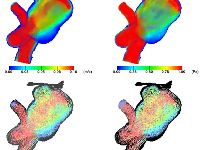 The Virtual Physiological Human initiative is a collection of European projects which undertake research in biomedical modelling and simulation of the human body. This will improve our ability to predict, diagnose and treat disease, and have a dramatic impact on the future of healthcare, the pharmaceutical and medical device industries.
The Virtual Physiological Human initiative is a collection of European projects which undertake research in biomedical modelling and simulation of the human body. This will improve our ability to predict, diagnose and treat disease, and have a dramatic impact on the future of healthcare, the pharmaceutical and medical device industries.
Vascular diseases are the cause of a large number of deaths in the developed world and the blood flow behaviour plays a crucial role in the understanding, diagnosis and treatment of many pathologies, but experimental studies are frequently impractical owing to the difficulty of measuring flow behaviour in humans. Hence modelling and simulation undoubtedly have a crucial role to play in haemodynamics. Simulation, for example, furnishes the clinician with the possibility of performing non-invasive virtual experiments to plan and study the effects of certain courses of (surgical) treatment with no danger to the patient, offering support for diagnosis, therapy and planning of vascular treatment. Modelling and simulation also offer the prospect of providing clinicians with virtual patient-specific analysis and treatments.
Within this domain lies HemeLB, a high performance lattice Boltzmann code for sparse geometries, such as those found in the vasculature. Currently, we can perform calculations sufficient to simulate, for example, a single aneurysm and a number of vessels connected to it. The resultant velocity, pressure and stress fields are visualised in situ and can either be written to disk locally or sent over the network to a connect client, which displays them and can steer the visualisation parameters. The scaling is currently limited by two factors: pre-processing of input data and communication imbalance due to the irregular domain decomposition. We are currently working to resolve these issues.
Simply scaling up the simulation domain to include the entire arterial tree at a resolution fine enough at the smallest scales would, within a monolithic application, be extremely inefficient. We plan to take a multiscale approach, using the techniques being developed within the MAPPER project. This approach will also allow us to couple the blood flow simulations to other physiological systems, such as vessel remodelling, tissue transport models, etc.; each of these simulations potentially requires a multi-petaflops level of performance. As we move towards a more faithful simulation of physiological processes, including more of the couplings between different systems at different scales, necessary to understand the human body as a single complex system, the computational requirements will rapidly approach the exascale. Learn more in this video:
